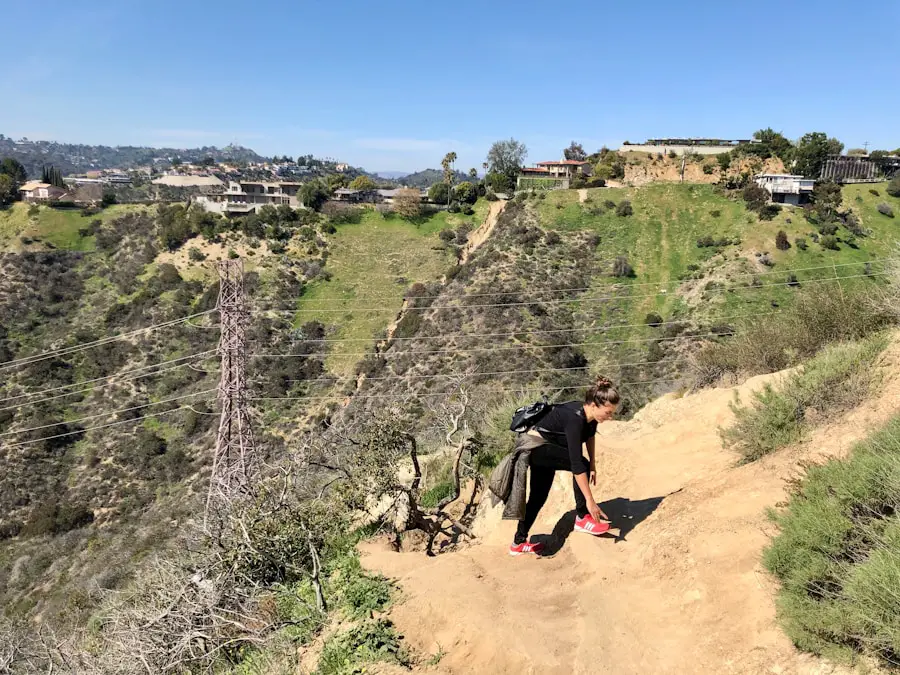Hiking is often celebrated for its scenic views and the opportunity to connect with nature, but its cardiovascular benefits are equally noteworthy. Engaging in this outdoor activity elevates heart rate, improves circulation, and enhances overall cardiovascular health. When a person hikes, especially on varied terrain, the heart works harder to pump blood throughout the body, which strengthens the heart muscle over time.
This increased heart rate can lead to improved oxygen delivery to tissues, enhancing endurance and stamina. Moreover, hiking can significantly lower the risk of cardiovascular diseases. Studies have shown that regular aerobic exercise, such as hiking, can reduce blood pressure, improve cholesterol levels, and decrease the likelihood of developing heart disease.
The rhythmic nature of hiking, combined with the natural resistance provided by uneven terrain, creates a unique workout that can be both enjoyable and effective in promoting heart health. The mental health benefits associated with hiking, such as reduced stress and anxiety, also contribute to cardiovascular well-being, as stress is a known risk factor for heart disease.
Key Takeaways
- Hiking can improve cardiovascular health by increasing heart rate and improving circulation, leading to a stronger heart and reduced risk of heart disease.
- Hiking provides similar cardiovascular benefits as traditional cardio exercises like running and cycling, while also offering the added benefits of being in nature and reducing stress.
- Inclines and varied terrain during hiking can further enhance cardiovascular benefits by challenging the heart and muscles, leading to increased calorie burn and improved endurance.
- To maximize the cardiovascular benefits of hiking, it’s important to maintain a brisk pace, use proper hiking gear, and stay hydrated to ensure a safe and effective workout.
- Incorporating interval training into hiking can boost cardiovascular fitness by alternating between periods of high intensity and lower intensity, leading to improved heart health and endurance.
Comparing Hiking to Traditional Cardio Exercises
When comparing hiking to traditional cardio exercises like running or cycling, it becomes evident that hiking offers a unique blend of benefits that can appeal to a wide range of fitness enthusiasts. Traditional cardio exercises often take place in controlled environments, such as gyms or tracks, where the intensity can be easily measured and adjusted. In contrast, hiking provides a dynamic workout that varies with each trail and landscape.
The natural variations in elevation and terrain not only challenge the body differently but also keep the mind engaged, making it less monotonous than some traditional forms of cardio. Additionally, hiking tends to be more accessible for individuals of varying fitness levels. While running may be daunting for beginners due to its high-impact nature, hiking allows individuals to choose trails that match their ability and gradually increase difficulty as they build strength and endurance.
This adaptability makes hiking an excellent option for those who may be recovering from injuries or looking for a low-impact alternative to high-intensity workouts. Furthermore, the social aspect of hiking—often done in groups or with friends—can enhance motivation and enjoyment, making it easier to stick with a regular exercise routine.
The Impact of Inclines and Terrain on Hiking Cardio

The cardiovascular benefits of hiking are significantly influenced by the inclines and terrain encountered along the trail. Steeper inclines require more effort from the cardiovascular system, leading to increased heart rates and greater calorie expenditure. For instance, a hike up a steep mountain trail can elevate heart rates to levels comparable to running, providing an intense workout that builds both strength and endurance.
Conversely, flat trails may offer a gentler workout but can still be beneficial for maintaining cardiovascular health. Terrain also plays a crucial role in determining the intensity of a hike. Rocky paths, sandy trails, or muddy surfaces require greater balance and stability, engaging different muscle groups and increasing the overall effort required.
This variability not only enhances cardiovascular fitness but also improves coordination and agility. For example, hiking on uneven ground forces the body to adapt constantly, which can lead to improved proprioception—the awareness of body position in space—ultimately contributing to better overall fitness.
Tips for Maximizing the Cardio Benefits of Hiking
| Tip | Benefit |
|---|---|
| Choose challenging trails | Increases heart rate and calorie burn |
| Use trekking poles | Engages upper body muscles and increases intensity |
| Interval hiking | Boosts cardiovascular endurance and burns more fat |
| Stay hydrated | Improves overall performance and prevents fatigue |
| Proper footwear | Reduces risk of injury and allows for longer hikes |
To fully harness the cardiovascular benefits of hiking, certain strategies can be employed to enhance the workout experience.
One effective approach is to choose trails with varying elevations and challenging terrains. Opting for routes that include steep ascents and descents can significantly increase heart rate and calorie burn.Additionally, incorporating intervals into hikes—alternating between periods of brisk walking or climbing and slower-paced recovery—can further elevate cardiovascular intensity. Another way to maximize cardio benefits is by using trekking poles. These tools not only provide stability on uneven terrain but also engage the upper body muscles, increasing overall exertion levels during hikes.
Carrying a weighted backpack can also add resistance, making the body work harder and enhancing cardiovascular conditioning. Furthermore, maintaining a brisk pace throughout the hike ensures that the heart rate remains elevated, allowing for sustained aerobic activity that promotes cardiovascular health.
Incorporating Interval Training into Hiking for Cardio
Interval training is a powerful method for enhancing cardiovascular fitness, and it can be seamlessly integrated into hiking routines. By alternating between high-intensity bursts of activity—such as sprinting up a hill or quickening the pace on flat sections—and lower-intensity recovery periods, hikers can significantly boost their heart rate and improve aerobic capacity. This approach not only maximizes calorie burn during the hike but also enhances endurance over time.
For example, a hiker might choose a trail with both steep inclines and flat sections. During the steep climbs, they could push themselves to hike at a faster pace or even jog briefly before slowing down during flatter areas to recover. This method not only keeps the workout engaging but also allows for greater cardiovascular conditioning than steady-state hiking alone.
Research has shown that interval training can lead to improved VO2 max—the maximum amount of oxygen the body can utilize during exercise—making it an effective strategy for those looking to enhance their overall fitness levels.
How Hiking Can Contribute to Overall Cardiovascular Health

Weight Management and Cardiovascular Health
Hiking can also play a significant role in weight management, a critical factor in cardiovascular health. Regular hikes burn calories and build muscle mass, leading to weight loss or maintenance of a healthy weight. This is particularly important, as obesity is a major risk factor for heart disease.
The Mental Health Connection
The mental health benefits associated with hiking, such as reduced stress levels and improved mood, can further support cardiovascular health by mitigating stress-related impacts on the heart.
Addressing Common Misconceptions About Hiking and Cardio
Despite its numerous benefits, there are several misconceptions about hiking as a form of cardiovascular exercise that may deter individuals from embracing it as part of their fitness routine. One common belief is that hiking is not an effective workout unless it involves steep mountains or rigorous trails. However, even moderate hikes on flat terrain can provide substantial cardiovascular benefits when performed consistently and at an elevated pace.
Another misconception is that hiking is only suitable for experienced athletes or those in peak physical condition. In reality, hiking is highly adaptable; individuals can choose trails that match their fitness levels and gradually progress to more challenging hikes as their endurance improves. This inclusivity makes hiking an excellent option for people of all ages and fitness backgrounds who are looking to improve their cardiovascular health without the intimidation often associated with more intense forms of exercise.
The Importance of Consistency in Hiking for Cardiovascular Fitness
Consistency is key when it comes to reaping the cardiovascular benefits of hiking. Engaging in this activity regularly—ideally several times a week—ensures that individuals maintain their fitness levels and continue to challenge their cardiovascular systems effectively. Just as with any form of exercise, sporadic participation may yield limited results; therefore, establishing a routine is essential for long-term success.
Setting specific goals can help maintain motivation and encourage consistency in hiking practices. Whether aiming to complete a certain number of hikes each month or targeting specific trails with varying difficulty levels, having clear objectives can enhance commitment to regular outdoor activity. Additionally, tracking progress through apps or journals can provide tangible evidence of improvements in endurance and overall fitness levels, further reinforcing the importance of consistency in achieving cardiovascular health through hiking.
If you’re looking to improve your cardiovascular fitness, hiking is a great way to do so. Not only does it provide a good workout for your heart and lungs, but it also allows you to enjoy the great outdoors and explore new places. For more information on the benefits of hiking for cardio health, check out this article on TakeTravelInfo.
Love travel? Join Our Facebook Community For More Tips.
FAQs
What is hiking?
Hiking is a form of outdoor activity that involves walking on trails or paths in natural environments such as mountains, forests, and countryside.
Is hiking considered a cardio exercise?
Yes, hiking is considered a cardio exercise as it increases your heart rate and improves cardiovascular fitness.
What are the benefits of hiking for cardio health?
Hiking can improve cardiovascular health by strengthening the heart, increasing lung capacity, and improving overall endurance.
How does hiking compare to other forms of cardio exercise?
Hiking offers the benefits of cardio exercise while also providing the added benefits of being in nature, which can reduce stress and improve mental well-being.
What are some tips for incorporating hiking into a cardio workout routine?
To incorporate hiking into a cardio workout routine, start with shorter, easier trails and gradually increase the distance and difficulty. It’s important to wear proper footwear, stay hydrated, and be mindful of the terrain.
